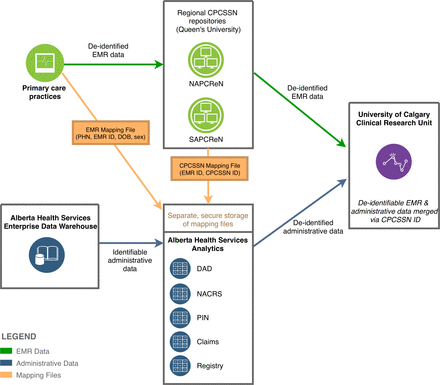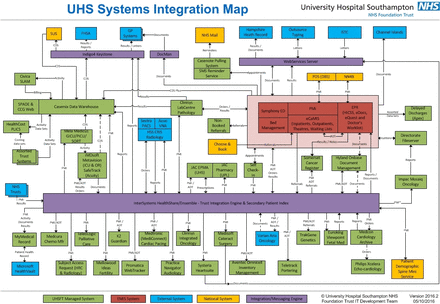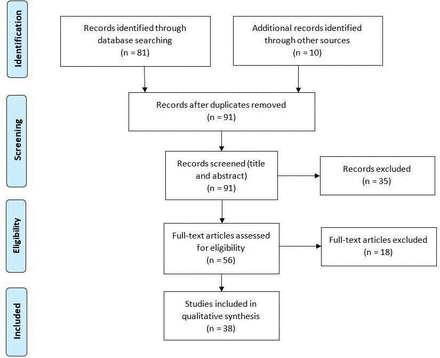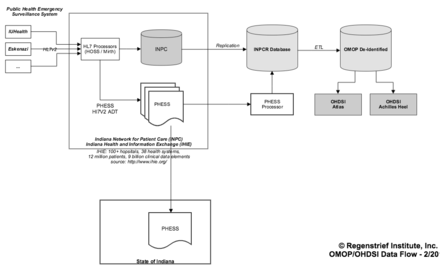Abstract
Objective To describe the process for linking electronic medical record (EMR) and administrative data in Alberta and examine the advantages and limitations of utilising linked data for hypertension surveillance.
Methods De-identified EMR data from 323 primary care providers contributing to the Canadian Primary Care Sentinel Surveillance Network (CPCSSN) in Alberta were used. Mapping files from each contributing provider were generated from their EMR to facilitate linkage to administrative data within the provincial health data warehouse. Deterministic linkage was conducted using valid personal healthcare number (PHN) with age and/or sex. Characteristics of patients and providers in the linked cohort were compared with population-level sources. Criteria used to define hypertension in both sources were examined.
Results Data were successfully linked for 6307 hypertensive patients (96.2% of eligible patients) from 49 contributing providers. Non-linkages from invalid PHN (n=246) occurred more for deceased patients and those with fewer primary care encounters, with differences due to type of EMR and patient EMR status. The linked cohort had more patients who were female, >60 years and residing in rural areas compared to the provincial healthcare registry. Family physicians were more often female and medically trained in Canada compared to all physicians in Alberta. Most patients (>97%) had ≥1 record in the registry, pharmacy, emergency/ambulatory care and claims databases; 44.3% had ≥1 record in the hospital discharge database.
Conclusion EMR-administrative data linkage has the potential to enhance hypertension surveillance. The current linkage process in Alberta is limited and subject to selection bias. Processes to address these deficiencies are under way.
Introduction
Chronic disease surveillance is an important public health function, which includes monitoring health events over time and examining processes of disease such as aetiology, treatment patterns, long-term management and health outcomes.1–3 In order to be effective, a robust surveillance system should include information that is current and timely, comprehensive, accurate, accessible at various levels, longitudinal, stable, flexible, cost-effective and population-based or representative of the population.1 4 5
In Canada, administrative data are often used for chronic disease surveillance, as it is routinely collected, longitudinal information on healthcare encounters for nearly the entire population.3 6 The proliferation of electronic medical record (EMR) systems in healthcare settings has now established EMR data as another option for disease surveillance.7 8 Both sources are not without limitations: administrative data lack important clinical indicators and risk factors, while EMR data are extracted for a small subset of the population and are more difficult to analyse.
Linking EMR and administrative data may help to alleviate respective shortcomings and enhance surveillance systems, yet this does not occur routinely and consistently across Canada for a variety of reasons: linkages must be conducted within each province and territory (if they are done at all) due to distinct provincial/territorial policies and health information legislation. Linkage processes can also vary depending on differences in health information laws, data holdings and data accessibility for secondary uses.
We used primary care EMR data from one Canadian province (Alberta) to conduct linkages with five administrative databases for patients with hypertension. Hypertension was chosen as an example chronic condition, as it has been identified as an important surveillance priority and is largely managed in primary care.9 10 Our objective was to describe the current process for EMR-administrative data linkage in Alberta and to examine the advantages, potential biases and limitations of using linked data for hypertension surveillance.
Discussion
This paper describes the process for linking de-identified primary care EMR data with administrative data in Alberta. Combining these sources increased the breadth of hypertension-related data, particularly with the addition of longitudinal blood pressure values and other physical measurements to several administrative data sources. However, the number of patients in the final linked cohort was small and the current process for data linkage may not be practical for province-level surveillance. Our focus has been on augmenting existing surveillance activities, but linked administrative and primary care EMR data could be a valuable addition for use in health services research, retrospective cohort studies and practice quality improvement.
The advantages and limitations of a linked EMR-administrative cohort with respect to important features and information needs of a surveillance system (box 1) will be discussed.
Criteria for a robust chronic disease surveillance system
Information needs for hypertension surveillance
-
Biological risk factors (eg, blood pressure, obesity/body mass index, pre-existing conditions, cholesterol & other lab markers).
-
Lifestyle risk factors (eg, smoking status, physical inactivity, alcohol use, diet).
-
Disease progression (eg, lab results, severity of disease).
-
Disease management (eg, medications prescribed and dispensed; medical procedures).
-
Health outcomes (eg, subsequent diagnoses, acute events requiring hospitalisation, mortality).
-
Environmental and policy factors.
-
Sociodemographics (eg, ethnicity, occupation, poverty).
-
Patient-reported outcome measures and experiences (eg, symptom burden, functional status, quality of life).
-
Healthcare costs.
Advantages
Comprehensiveness
The most significant advantage of this type of data linkage is the creation of more comprehensive information about people with hypertension, more so than either data source on its own. For instance, smoking status, weight trajectories over time, medication prescriptions and longitudinal blood pressure measurements recorded in primary care practices are now available alongside pharmacy-dispensed medication records and acute outcomes requiring hospitalisation, which does not exist currently in Alberta. This combination of community-based, detailed clinical information and system-wide healthcare encounters can help to enhance our understanding of disease processes, management and outcomes.
Completeness
Linking EMR and administrative data can also help to improve data completeness and evaluate the accuracy of data elements. The Electronic Medical Record Administrative data Linked Database in Ontario, Canada has demonstrated this in their assessment of prescribed medication validity in EMRs compared to a provincial drug database, as well as using linked data to confirm a variety of administrative-based disease identification algorithms.20–23
Timeliness
Both administrative and EMR data are available in a timeframe suitable for chronic disease surveillance, as real-time data are not necessarily warranted for conditions that have a long latency period. However, the linkage process described here took just over 1 year to complete, after research ethics approvals, obtaining sentinel agreements to link EMR data, generating the mapping files at each of the participating clinics, and completing the EMR and administrative linkage. Even so, updating linkages once per year, for example, would still be reasonable for hypertension or other chronic disease surveillance.
Limitation and potential biases
Coverage of capture
The primary care setting represents citizens who have accessed the first level of the healthcare system and the CPCSSN database is a further subset of these patients whose providers consented to participate. The CPCSSN data from Alberta were observed to include higher proportions of physicians who were female, completed medical training in Canada and practice in rural locations. Patients in the Alberta CPCSSN data were more likely to be female, older and located in rural areas compared to all AHCIP registrants, although this reflects a typical primary care population in terms of older adults and women.14
One major limitation of this current approach to EMR-administrative data linkage is the potential for selection bias to occur. Data required for surveillance should ideally be population-based or at least representative of the broader population. There was a clear discrepancy in the low proportion of urban patients included in the linked dataset; in addition, the providers contributing to the CPCSSN database and the linkage may potentially differ from the broader population of providers for reasons we are unable to measure (eg, more comfortable with data or research; record information differently in the EMR).
Completeness and accuracy
Although this linkage brought together previously discrete data about patients with hypertension, risk factors and other information relevant to hypertension surveillance are still missing or incomplete. For example, smoking status and alcohol use are often entered inconsistently as free text in EMRs and may not be recorded for all patients in an extractable format, which limits their usability.24 25 Environmental and socioeconomic factors also contribute to the aetiology and management of hypertension; however, neither primary care EMR nor administrative health data capture this information sufficiently. This highlights the need for additional data linkage to occur with multiple health and non-health sources (eg, ministerial data from occupation, education, social services; surveys; geographic information systems (GIS) mapping), while still respecting individual privacy and maintaining minimal risk of re-identification.
There were a few issues with the accuracy of the linkage process. Duplicate patients were found in the AHCIP Registry due to different year of birth or sex recorded between subsequent registration years; however, this represented a very small proportion of patients (0.1%). Another challenge related to the process of generating the mapping files. Because CPCSSN extracts data from five different EMR systems in the province, there are variations in the EMR data extraction methods (which also generates the CPCSSN mapping files) and creation of the EMR mapping files from each clinic, as well as differences in how patients are assigned (or not assigned) to providers in the EMR. This was evident in the differing linkage rates by EMR type, by deceased status (which is not necessarily known or recorded in primary care settings) and in the EMR status of patients in the clinic (eg, whether only active or all patients were included in the mapping files). The process for extracting the mapping files in the clinic EMR and the criteria for patient selection requires further standardisation.
Misclassification
Misclassifying those who truly have or do not have hypertension by the case finding algorithms can greatly bias epidemiological or surveillance outcomes. Previous validation studies have shown that the EMR-based definition for hypertension outperformed the administrative definition in both sensitivity (84.5% vs 75%) and PPV (92.9% vs 81%).18 19 In this cohort, 564 (8.9%) of the hypertensive patients in the EMR were not identified as hypertensive in the administrative data; this may be due to a longer timeframe of available data in the EMR or less frequent hypertension billing claims submitted for patients with long-term control.
Poor data quality can also contribute to misclassification through data entry errors in the clinic EMR from the use of non-specific or no diagnostic codes, information recorded in inaccessible formats (eg, free text notes; scanned documents) or errors produced during CPCSSN processing.26 Since the administrative definition for hypertension only uses the ICD-9 billing codes and a smaller number of ICD-10-CA codes within in-patient data, this may further limit the ability of the administrative data to identify all true cases of hypertension and thus, linkage with detailed EMR data can augment case definition accuracy.
Conclusion
EMR-administrative linkage can result in novel, rich data for hypertension surveillance. The linkage process described here is limited in terms of its small sample size and generalisability; however, this work will inform the development of a more efficient and robust process for data linkage. In addition to surveillance, this type of linkage could also be used to strengthen retrospective cohort studies by supplementing administrative data with the rich details found in EMR data. Expanding linkages to include data from other sources, as well as increasing the number of practitioners contributing to the linkage, would further enhance the applicability for hypertension surveillance and epidemiology.





